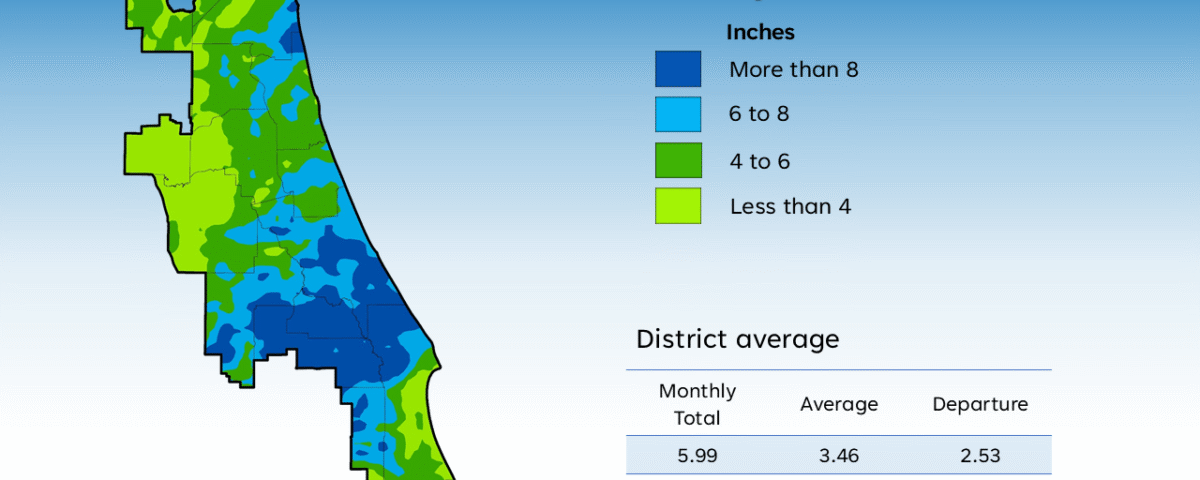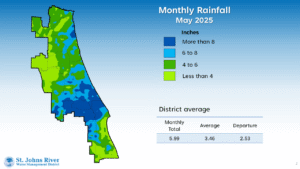Rain returns to the District in May, water conservation remains a priority

A map illustrates rainfall conditions in May across the St. Johns River Water Management District.
Rainfall across the District in May marked a notable shift, with precipitation levels rising above average for the first time since January. Most rain occurred at the beginning and end of the month, with drier conditions in between. Rainfall amounts varied widely, from just over 3 inches in Alachua County to over 8 inches in parts of the I-4 corridor, including Seminole, Orange and portions of northern Brevard and southern Flagler counties.
Despite the increased rainfall, aquifer levels generally declined, but most of the District remains within the normal range for groundwater conditions.
As we enter the rainy season, it is important to remember that water conservation matters all year long. Maintaining healthy aquifer levels helps support Florida’s water supply during the drier months when rainfall is less abundant.
A full report outlining May’s hydrologic conditions was presented at the District’s Governing Board meeting. Highlights include:
Rainfall
- Districtwide rainfall averaged 5.99 inches, which is 2.53 inches above the monthly norm.
- Rainfall totals varied across the region, ranging from 10.07 inches in Seminole County to just 3.04 inches in Alachua County.
- Annual rainfall across the District was 53.29 inches, above the long-term average by 2.28 inches.
- Northern and central counties continue to receive the most rainfall throughout the year, while areas along the southern coast and western portions of the District have received less.
- Ten counties have recorded above normal annual rainfall, with five counties more than 5 inches above their annual average including Nassau, Duval, Volusia and Seminole and Orange counties. Eight counties are below their 12-month average, with Alachua and Baker counties more than 3 inches below normal.
Groundwater
- Conditions in the Upper Floridan Aquifer have shown decreases in water levels across most of the District, with 80% of sites recording declines. However, the majority of the District remains in the normal range.
- Districtwide groundwater levels, expressed as a single index, were in the 48th percentile, which is in the normal range for this time of year.
Spring flows
- Silver Springs recorded a mean monthly flow of 592 cubic feet per second (cfs), or 383 million gallons per day (mgd), a 56 cfs decrease from last month and is just in the normal range for this time of year.
- In Volusia County, the Blue Spring station reported an increase of 1 cfs in May with a mean monthly flow of 164 cfs (106 mgd).
- Mean monthly flow at Rock Springs was 60 cfs (39 mgd), and remains in the high range.
- Wekiwa Springs recorded a mean monthly flow of 63 cfs (41 mgd) continuing to be in the normal range.
For further insights into rainfall totals and other hydrologic data, visit www.sjrwmd.com.
Visit WaterLessFlorida.com for tips to help landscapes thrive while saving water and money. Follow the water conservation conversation at #sjrwmd #waterconservation #savewater.


